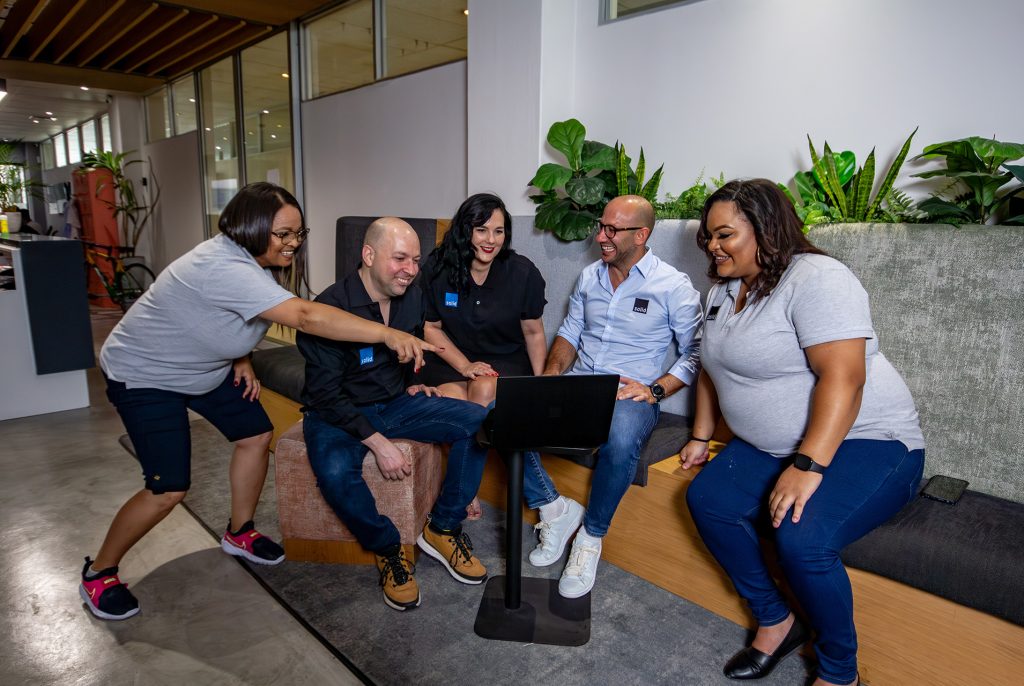
Over the past two years, there is one technology that we have seen more growth in than any other: Artificial Intelligence. Generative AI in particular has advanced in leaps and bounds over the past year, with platforms emerging on a practically daily basis that help businesses to take advantage of the technology in areas from marketing and social media, to automating daily tasks, perfecting email communication and more.
But, as is always the case in Information Technology, there is a lot of confusion about what the phrases machine learning vs. Artificial Intelligence mean, or AI vs. generative AI. I thought I’d take this opportunity to clear things up, explain what the different acronyms mean, delve into what the difference between AI and machine learning is, explain how you could be using the technologies to grow your business, and (possibly most importantly) look at whether AI is going to be taking over your humans’ jobs in the near future. So, let’s dive in!
What Is Artificial Intelligence?
Artificial Intelligence (AI) is the branch of computer science that deals with the development of intelligent machines. These machines are able to perform advanced tasks that we’re used to only the humans in our businesses being able to do – things like decision making, detailed and accurate translation, understanding visual cues, leveraging creativity, and more. But the more advanced AI becomes, the more ‘human’ tasks it’s able to perform.
AI has been around for a while now but recent advancements in deep learning and neural networks have allowed AI to take on more sophisticated tasks than ever before. Generative AI is a great example of this, as it allows machines to create new content and ideas that are indistinguishable from something a human would produce.
What Is Generative AI?
Generative AI is the next step in Artificial Intelligence development. It uses deep learning algorithms and neural networks to generate new content, ideas and even images. The idea is that the AI learns how to generate these things by training on existing data. For example, an AI trained on famous paintings could then create its own unique pieces of art.
Generative AI can take on tasks like story creation, music composition, image generation and more. It’s a fascinating technology that has endless creative possibilities. But where does machine learning fit into all of this?
What Is Machine Learning?
Machine learning (ML) is a subset of AI that focuses on teaching machines how to learn and improve from data, without being explicitly programmed. Instead, the machine uses algorithms and statistical models to find patterns in data and make predictions or decisions based on those patterns.
The more data an ML model is trained on, the better it becomes at making accurate predictions or decisions. This allows machines to take on a wide range of tasks, from recognising objects in images to helping with medical diagnoses.
How Are AI And ML Connected?
Rather than looking at machine learning vs Artificial Intelligence, you need to understand that AI and machine learning are closely connected, as ML is one of the main techniques used in AI development. In order for an AI system to be able to learn and adapt, it needs to have some form of machine learning capability.
AI systems can also use ML to improve their performance over time. For example, a chatbot powered by AI could use ML to analyse its conversations with users and constantly improve its responses.
What Are the Difference Between AI and ML?
While they are closely connected, there are some key differentiating factors between the two platforms. The main difference between AI vs ML is that Artificial Intelligence is a broad term that encompasses any technology or system that can imitate human intelligence, while machine learning specifically works with datasets, analysing them to provide deeper and more powerful insights than a human would be able to manage, in a fraction of the time.
Another difference between AI and machine learning is the level of autonomy involved. Most AI systems are designed to be fully autonomous, whereas ML models require human intervention to train and improve.
What Are The Benefits of Using AI and ML Together?
When AI and ML are combined, they become a powerful combination that can bring many benefits to businesses and industries. Some of the key advantages include:
• Analytic Integration
When AI and ML are used together, you can achieve a higher level of analytic integration. This means that data from different sources can be combined and analysed in a more comprehensive way, leading to better insights and predictions, and giving management a more thorough understanding of your operations.
• Wider Data Ranges
AI systems are able to process large amounts of data quickly, but by adding machine learning techniques, this range can be expanded even further. This allows for more accurate and comprehensive analysis of data, leading to better insights and predictions.
• Decisions Backed By Data
By taking advantage of AI and ML together, you can make decisions based on data and trends in your markets rather than relying on intuition or guesswork. This can lead to more informed and successful decision making.
• Faster Decision Making
With the ability to process large amounts of data quickly, AI and ML can provide businesses with insights and predictions in record time. This means that you’re not only able to make well-informed decisions backed by data, but you can make them faster than ever before, which is crucial in today’s fast-paced business world.
• Efficiency
By automating processes and tasks through AI and ML, you can increase efficiency and productivity throughout your company. This frees up human resources to focus on growing your business, rather than spending all their time grinding away at data processing and sifting through emails to compile to-do lists, for example. Not only can this lead to improved overall performance, but it can increase your humans’ lives, giving them more time to do the things they love and are good at.
Which Industries Are Using AI And ML?
Now that you have a bit of a better understanding of machine learning vs Artificial Intelligence, let’s take a look at some of their applications in the business world. AI and ML are being used across a wide range of industries to improve processes, make more accurate predictions, and drive business success. Some industries that are currently taking advantage of AI and ML in innovative ways include:
• Financial Services
In the financial services industry, AI is being used for fraud detection, risk assessment, and investment predictions. ML algorithms can analyse vast amounts of financial data to identify patterns and make more informed decisions. This can lead to increased profits and better risk management.
• Ecommerce And Retail
AI and ML are revolutionising the ecommerce and retail industries by improving customer experience through personalised recommendations based on past purchases and browsing history. These technologies can also be used for inventory management and fraud detection, making online shopping safer for consumers.
• Manufacturing
AI and ML are helping manufacturers optimise their production lines by predicting maintenance needs, reducing downtime, and improving product quality. These technologies can also be used to streamline inventory management and supply chain processes, leading to cost savings and increased efficiency.
• Healthcare And Life Sciences
In the healthcare industry, AI is being used to help identify patterns in medical images such as MRIs and X-rays, making diagnoses faster and more accurate. It is also being used to assist in drug discovery and development, allowing for quicker identification of potential treatments for diseases.
• Telecommunications
AI and ML are helping telecommunications companies improve network performance by predicting potential outages and optimising network usage. These technologies are also being used to analyse customer data and provide personalised offerings, improving customer satisfaction and retention.
Are AI And ML Going To Replace Humans?
Now for the big question, and one that a lot of people are concerned about. Rather than worrying about machine learning vs. AI, with the advancements in Artificial Intelligence, a lot of people are worried that as AI takes over more and more tasks, and generative AI in particular draws on existing works to boost the potential for creativity, the people who were previously responsible for these jobs and creative processes are going to find themselves without jobs. So are AI and ML going to replace the humans in your business?
This is something that I’ve given a lot of thought to over the past year. As someone who loves technologies and the ways that they are advancing our societies, I’m excited by the way that AI is progressing. But at Solid Systems, we have always said that we are humans, not robots. And doesn’t AI contradict that statement? If we’re using AI throughout our business, then how can I say that we’re human not robots, when machines are doing half of our work?
The truth is, there’s a saying that I came across just when this big boost in AI was beginning. ‘AI isn’t going to replace you. Someone who knows how to use AI will.’
We have so much knowledge and power at our fingertips, and to ignore it would be to our detriment. Businesses around the world are adopting Artificial Intelligence and machine learning into their systems and processes, and if you don’t do the same, you will be left behind. But over the past year, as I’ve seen what AI is capable of, I’ve also seen how ‘stupid’ something so intelligent can be at times. If you’ve ever prompted ChatGPT, for example, and received absolute made up gobbledygook in return, or have seen posts of others who love to point out the trash that ChatGPT can generate, then you’ll understand what I mean.
AI and ML are only as useful as the person behind them, prompting them, providing insights and detail into exactly what they want. They are tools designed to help humans, not replace them. AI and ML excel at tasks that involve data analysis and pattern recognition, but they lack the human traits of empathy, emotional intelligence, and the ability to understand context beyond data.
Instead of viewing AI and ML as a threat to job security, we should see them as tools that can take over mundane tasks, freeing our humans to focus on more strategic, creative, and impactful aspects of their work. In this sense, AI and ML are not replacing humans but rather augmenting human capabilities and transforming the way we work.
Frequently Asked Questions
Generative AI and Machine Learning (ML) are subsets of Artificial Intelligence, but they serve different functions. Generative AI is focused on generating new, creative content such as text, images, or music. On the other hand, ML is a tool that enables AI to learn from data inputs and improve its performance over time without being explicitly programmed to do so.
Yes, AI can work without ML. Artificial Intelligence is a broad field which encompasses various techniques and methods, not limited to Machine Learning. Traditional rule-based systems, expert systems, and genetic algorithms are examples of AI that don’t require Machine Learning. However, Machine Learning has become a popular tool within AI due to its ability to learn and improve from data.
The short answer is no. But the longer answer is that someone who knows how to use them well might. Businesses are adopting these tools left, right and centre, and if you don’t learn how to use them to your advantage, how to prompt them in the right ways to get the results that you need, and how to automate tasks that don’t necessarily need human input, you are going to fall behind the curve and find yourself at a disadvantage.
Popular Searches
- IT Company in Johannesburg
- IT Company in Polokwane
- Types Of Data Integrity
- IT Company in Sandton
- Leveraging Artificial Intelligence
- IT Company in Centurion
- Network Security Threats
- IT Company in Cape Town
- Preventing Cyber Attacks
- IT Company in Pretoria
- IT Company in Midrand
- What is Data Breach
- IT Company in Gauteng
- What Is Cyber Espionage
- IT Company in Durban
- Advanced Threat Protection
- Cyber attacks examples
- Digital Security





